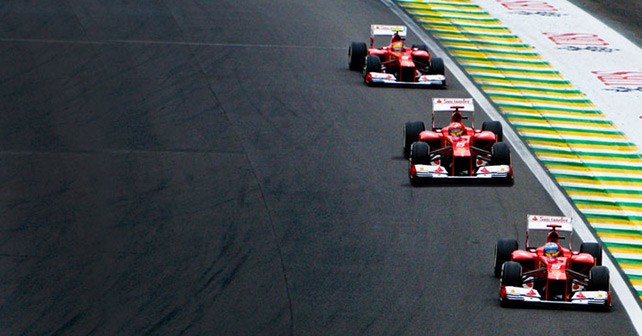
Last month’s column, Can we Build a Better Sport, received great feedback from my regular set of readers, and I’m glad you liked it. This month, I make an attempt to add a bit of spice to our sport – especially after we received the bland news of HRT wrapping up over the winter, and their equipment being bought out by various recycling companies and a scrap dealer! This means that we will have 2 less cars on the racing grid this season. It also means that India’s most experienced Formula 1 driver, Narain Karthikeyan, may not be racing in 2013. I don’t know which thought upsets me more though.
This brings me to a topic that Ferrari Chairman, Luca Montezemolo, has been very vocal about in the recent past – i.e. Formula 1 teams running three-car teams. A thought that faced support from few, and opposition from many in the Formula 1 Paddock (well, what doesn’t). However, here’s why I’m massively in favour of three-car teams in Formula 1.
The ‘Constructor’ status is well defined in Formula 1, and there are limits to what technology teams can purchase as a ‘customer’ from other Formula 1 teams. Currently, the purchase of engines, KERS systems and gearboxes are most common. However, the aero components, development of the suspension and chassis, all have to be done by the team itself.
While this arrangement seems fair, given our current regulations (which are very aero heavy), the mid and bottom grid teams have to find their own way to design and develop an efficient and quick racing car. As obvious as this seems for a racing team, in reality (like in other forms of racing), success in Formula 1 is directly proportionate to the amount of investment made. Therefore, teams with mediocre budgets are unable to break into the competitive mid-field, and even more competitive front-end of the grid. Case in point being Caterham and Marussia, who have failed to score a single championship point in three seasons, and seem content fighting for 10th place in the Constructors’ Championship.
On-track, the result is having cars that lap a few seconds slower than a Ferrari, McLaren or Red Bull – affecting not just on-track performance (and safety), but also the image of the sport to fans and stakeholders. Not to mention the image it creates for those teams and their sponsors. Certainly not a win-win situation for the sport and its multiple stakeholders!
I hope this provides some clarity on what Montezemolo has been meaning to point out.
So, for a few moments, let’s imagine that there were three car teams in the sport. On the basis of our current scenario, this would mean that we would have 33 cars racing on the grid in Melbourne. But that’s not the point. Let’s consider quality over quantity here.
We would have three Ferrari’s, McLaren’s, Mercedes’ (if they’re quick!) and others. And the majority of these cars would be equal (don’t we all want that?), and the greatest difference would in their different liveries. The ‘third’ car in each team would in effect be a car owned by a privateer team that uses the exact same equipment as the manufacturer team, and only has to manage drivers, sponsorships, marketing and merchandise operations – since their technical operations would be ‘bought’ as a service.
The result would be a far more competitive grid from the front-to-rear – something that current Formula 1 fans have rarely witnessed and enjoyed. Every team and driver would be able to boast of world-class equipment rather than complain about the lack of it. A better spectacle would boost TV viewership, which would in turn would positively influence sponsorships and revenues for all stakeholders of the sport, which includes the FOM, FIA, FOTA, drivers, sponsors, and, of course, the fans (more bang for our buck, literally)!
Sport teaches us the adage ‘play to your strength,’ and that’s exactly what this concept would let F1 do. The privateer teams would leave the complex designing and manufacturing of racecars to the manufacturers, while focusing their energies on building a world-class racing team brand that is commercially viable.
Historically, only a few privateer teams have come forward to beat the manufacturer teams in our sport. If they have, they’ve done so on a not so consistent basis. The 90’s saw the dominance of Williams F1, and currently it’s Red Bull Racing. However, in this same period, we have seen more privateer teams fade away into oblivion due to the investments the sport demands. While I might sound completely crazy, I do believe that if the sport’s organisers were to explore this idea, it could actually turn out to be a good one.
Lastly, here’s a bit of humour on who could actually drive the ‘third’ car for each team. What if the third cars were driven by famous former Formula 1 drivers? Hakkinen, Villieneuve, Barrichello, Trulli and even Irvine are names that I can immediately think of! Third cars could also be given to deserving rookies who probably couldn’t find a seat due to lack of funding. Neel Jani, Bruno Senna or even Karun Chandhok? And maybe, just maybe, we could reach a stage where teams don’t rely on pay drivers to fund their operations. Wishful thinking it may just be…

















Write your Comment